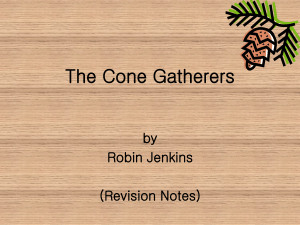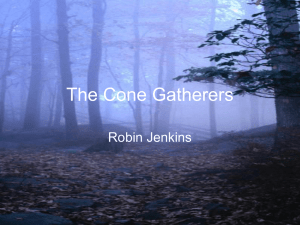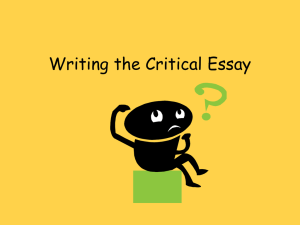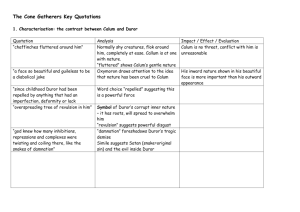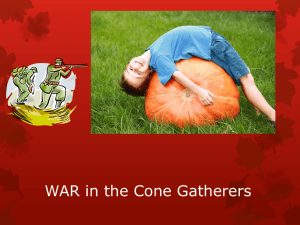The Cone Gatherers Notes
advertisement
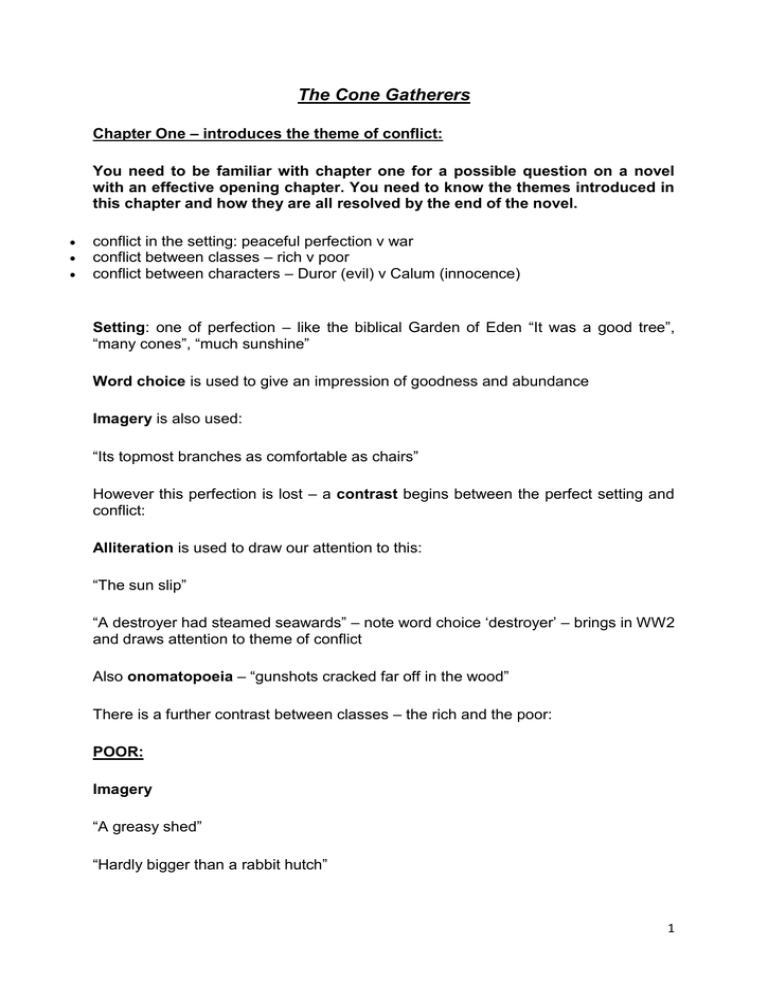
The Cone Gatherers Chapter One – introduces the theme of conflict: You need to be familiar with chapter one for a possible question on a novel with an effective opening chapter. You need to know the themes introduced in this chapter and how they are all resolved by the end of the novel. conflict in the setting: peaceful perfection v war conflict between classes – rich v poor conflict between characters – Duror (evil) v Calum (innocence) Setting: one of perfection – like the biblical Garden of Eden “It was a good tree”, “many cones”, “much sunshine” Word choice is used to give an impression of goodness and abundance Imagery is also used: “Its topmost branches as comfortable as chairs” However this perfection is lost – a contrast begins between the perfect setting and conflict: Alliteration is used to draw our attention to this: “The sun slip” “A destroyer had steamed seawards” – note word choice ‘destroyer’ – brings in WW2 and draws attention to theme of conflict Also onomatopoeia – “gunshots cracked far off in the wood” There is a further contrast between classes – the rich and the poor: POOR: Imagery “A greasy shed” “Hardly bigger than a rabbit hutch” 1 Assonance draws attention to their filthy state: “the ground round about was filthy with their refuse and ordure” RICH: Symbolism “A private fence of giant silver firs” “private” – the poor are to be kept out “fence” – a symbol that there is a real division between rich and poor “giant” – this division is huge “silver” – connotations of wealth – the division is for the benefit of the rich Conflict between characters: Duror v. Calum Calum – an innocent character, in touch with nature “chaffinches fluttered around him” connotations with St Francis of Assisi – suggests Calum’s innocence and saint like characteristics “fluttered” suggests his gentleness and trustworthiness “He (Neil) knew what Calum represented, pity so meek” “on the misshapen hump of his body sat a face so beautiful and guileless to be a diabolical joke” Oxymoron “diabolical joke” draws attention to the juxtaposition of Calum’s hideous shape on the outside and his beautiful nature on the inside The incident with the rabbit demonstrates that Calum can’t harm any living creature “I couldn’t Neil” Duror – the personification of evil In order to develop a response to Duror you must refer to the extended metaphor of a decaying tree which Jenkins uses to develop his character. This tree has roots, casts shade and eventually grows ‘fruit’ – outcomes “the overspreading tree of revulsion in him” ‘overspreading’ – suggests it will overwhelm him and affect others 2 ‘revulsion’ – a powerful word of disgust Roots of this are in childhood: “Since childhood Duror had been repelled by anything living that had imperfection, deformity or lack” Calum’s arrival in the wood has unsettled Duror (because of his outward deformity) and this causes Duror to obsessively dislike the cone gatherer ‘he had waited over an hour to see them pass’ His unreasonableness is shown by ‘he was alone in his obsession’ ‘but in him was a force more powerful than common sense or pride. He could not name it, but it dragged him irresistibly down towards that hut” This force created a fantasy of destruction which foreshadows the outcome of the novel: “He saw himself returning, kicking open the door, shouting at them in disgust, and then blasting them both to everlasting perdition. He felt an icy hand on his brow as he imagined that hideous but liberating fratricide.” Duror, unreasonably, believes that if he kills Calum then the unsettled feelings will go and life will return to normal. However, there is another, more historic root to his mental state. Chapter 2 – Duror’s relationship with his wife, Peggy The chapter begins with Duror’s encounter with Dr Matheson. Dr Matheson’s role in the story is to be the reliable character whose judgment we can believe and trust. 1. Dr Matheson worries about what was going on inside of Duror’s mind – he explores the roots of Duror’s internal conflict. (p.16) “God knew how many inhibitions, repressions and complexes were twisting and coiling there, like the snakes of damnation.” – in this use of imagery Dr Matheson makes a clear link with evil comparing Duror’s condition with The Snake – Satan or the Devil himself. 2. Note where Duror placed his gun. (p.14) “Duror climbed in, placing his gun beside the doctor’s bag on the back seat.” – in this image two possible outcomes for Duror are foreshadowed – medical treatment or violence. 3 3. The writer’s description of Peggy (p20.) “The sweetness of her youth still haunting amidst the great wobbling masses of pallid fat that composed her face added to her grotesqueness a pathos that often had visitors bursting into unexpected tears.” The writer uses word choice: “haunting” suggests Peggy is a ghost of her former self – creates sympathy “wobbling masses of pallid fat” – creates disgust and hints at the roots of Duror’s problem, his disgust at her deformity, she literally shows how big Duror’s disgust and internal problems are “grotesqueness” a strong word suggesting horror but sympathy “pathos” towards her for becoming like this 4. Mrs Lochie’s (Peggy’s mother’s) anger towards God (p.24) Her role is to be the antagonist – she outwardly voices some of Duror’s inner thoughts She antagonises Duror about the causes of Peggy’s illness. Is it because Peggy has deserved it? Is it a punishment for Duror? The antagonism at home makes Duror seek peace in the woods with his dogs. “Even if I had a guarantee in my hand this very minute, saying that Peggy in heaven would have it all made up to, I still wouldn’t be satisfied. It seems to me a shameful thing, to torment the living unjustly and think to remedy it by pampering the dead.” 5. The writer’s description of Calum’s face (p.25) “His face with its hellish beauty” Another example of how Jenkins uses oxymoron to draw attention to the conflict between Calum’s outward appearance and his inner nature (refer back to note in Chapter 1) This is a successful choice of technique because oxymoron is the bringing together of two opposites to make a point 4 3. Chapter 3: The spreading of the lie (overspreading tree of revulsion) 1.The lie to Forgan “I’m afraid we’ve had a disturbed night. I see I’ve forgotten to shave.” 2. Mrs Lochie’s Accusation “she accused us of being in bed together, but she put it more coarsely than that.” 3. The accusation about Calum “I saw that imbecile exposing himself… and worse.” Is Duror projecting onto Calum his own behaviour? Symbolism: The symbol of ‘seed’ a) Good or innocent ‘seed’ Duror refers to the gathering of cones, calls them ‘seed’ and the beautiful wood which will grow back from them. (p.37) b) guilty seed two sexual references – semen as seed - Duror and Mrs Morton - could Duror’s sexual repression be resolved with an affair? Effie’s old body disgusts him By rejecting this possibility he sets his face towards his doom. - the lie about Calum exposing himself Chapter 4 – Further spreading of the lie – Lady Runcie-Campbell Pay attention to LRC’s contribution to the novel as she is useful for a possible answer on an important minor character, or a minor character whose actions influence a novel. 2 key issues The spreading of ‘the lie’ 5 The ‘flaw’ in Lady Runcie-Campbell’s (RLC’s) character – whenever an important decision needs to be taken she defers to Duror “Now when he was going to lie again, knowing it would implicate her in his chosen evil.” (p.41) “chosen” suggests that his actions are deliberate, he still has control. “It astonished him that she, so generally good, should be helping him in his plan of evil.” (p.49) The ‘flaw’ in LRC’s character (characterisation of LRC) “She would have given the cone-gatherers the use of the beach hut, if Duror had not dissuaded her…” (p.41) (Master Roderick and the gun) “I’m going to abide by your decision” (p.44) (Mr Tulloch phones back about using Calum in the deer drive) “Do you mind if I consult my gamekeeper for a second?” (p.48) Her flaw is her unwillingness to take responsibility and to avoid blame. Chapter 5 – Duror continues to decline – the plot of the Deer Drive “He had not anticipated… the sickening of his very will to hate… It seemed to him that he must therefore be far more ill and decayed than he had thought. He was like a tree still straight, still showing green leaves; but underground death was creeping along the roots.” The word choice and imagery show: The decline in Duror – he is sickening, becoming ill The growing root of evil That the end result is inevitably death Chapter 6 – Turning Point – the Deer Drive Chapter 6 forms a turning point in the novel Duror’s plan to get rid of Calum in the deer drive comes to a head Duror’s growing madness comes out in public – in front of nearly all of the key characters. Calum throws himself on the deer, Duror throws Calum off and violently slits the throat of the deer, as he thinks it is Peggy – this links back to Chapter 2 6 and the revelation that the root of his problem is sexual frustration caused by his wife’s illness “Rushing upon the stricken deer and the frantic hunchback, he threw the latter off with furious force, and then, seizing the former’s head with one hand cut the throat savagely with the other.” Note the word “savagely” which shows Duror’s change from human to savage - this links to the idea of turning point as Duror has changed Note also the violent word choice. “Peggy?” he asked. “What’s happened to Peggy?” This shows what was actually in Duror’s mind when he slit the deer’s throat. The root of the anger is connected to Peggy and deformity But when he looks at Calum Duror realises something about himself: “He understood for the first time why he hated the hunchback so profoundly and yet was so fascinated by him. For many years his life had been stunted, misshapen, obscene and hideous and this misbegotten creature was its personification.” This is Duror’s insight (useful for Higher questions on characters who experience insight) Calum's outward appearance is like Duror’s inward appearance. This unsettles Duror as it provokes him to madness with fatal consequences. The killing of the Deer also foreshadows the conclusion of the novel when a further violent incident will take place. However, although Calum’s role in the Deer Drive is in one way effective – his behaviour offends LRC and spoils her plan to give her brother a pleasurable shoot before he returns to War thus causing her offence, she defers to Duror and agrees that they can stay as long as they do not bother her. This will link to the later scene at the Beach Hut when cause her further offence. Be clear about what led up to the Deer Drive What happened during the Deer Drive And the consequences which follow You will need to know this for questions on turning points 7 Chapter 7 – Duror’s unreasonable madness is further exposed In this chapter the macrocosm (WW2) touches the microcosm (Lendrick). The main development here is the respect shown towards the cone gatherers: shopkeepers, policemen and in the café. This forms a contrast to the lack of respect shown towards TCG by LRC and Duror. The author’s purpose is to develop the reader’s sympathy towards Calum and Neil and to make the events which follow all the more unreasonable and cruel. Chapter 8: The theme of social conflict The themes of innocence and social conflict are revisited in the scene with Roderick and the car. “He did not see things or people as a baronet’s heir should” (p.91) (links with Roderick and Calum are being made) “We carried dogs in the car” Roderick’s innocence is shown in the way that he has not grasped the differences between social classes. The incident with the car foreshadows a larger social conflict later when Roderick will believe again that his mother acts unreasonably towards the cone gatherers. Note again LRC’s need to defer to Duror (her flaw). “Ought I to offer these people a lift” – note how LRC distances herself 2. Duror’s appointment with Dr Matheson As a consequence of the scene at the Deer Drive Duror has a doctor’s appointment .The theme of internal conflict is revisited in the scene with Duror and Dr Matheson. Duror gets a diagnosis of the roots of his illness. Dr Matheson continues to be the reliable witness so his conclusion is right: This is the reason for Duror’s madness: “Since your wife’s illness you have never had relations with her?” “Therefore you have lived like a monk ever since. This has set up stresses and now it is affecting you physically.” (p.102) The doctor looks at ways in which Duror can address this problem: “Other women” (break religious and social rules, and affair was unacceptable in this community) 8 “Religious acceptance” (have “faith” but Duror does not believe in God) “Endurance” – this is the doctor’s advice, they drink a toast to it: “Aye, to endurance.” (p.103) Chapter 9: a second turning point – Duror rejects the Doctor’s advice Chapter 9 is the second turning point in the novel. It marks the end of hope and the beginning of the end. Duror rejects the doctor’s advice and goes drinking. “The result was a revulsion against the doctor’s reiterated philosophy of endurance…” (the doctor’s bag is rejected) (p.104) Note word choice “revulsion”: a powerful disgust – Duror totally rejects the idea of “endurance” – there is no way he can live with this “He (Duror) felt in a mood for murder, rape or suicide” (p.104) This reveals Duror’s true emotional state and foreshadows the end of the novel. Why murder? – Duror believes that getting rid of the cone gatherer will resolve the terrible feelings inside of him, Calum’s appearance in the wood unsettled him, his removal should settle him down again. Duror will ultimately kill Calum. Why rape? – this reinforces the root of sexual frustration but this is directed towards Calum, are the lies about Calum masturbating really projections of what Duror himself was doing? Duror will sexually assault something. Why suicide? – this reinforces Duror as an isolated character. He feels alone in this and has lost the will to live. Duror will kill himself. Note Duror as an isolated character – this is useful for questions on this. You need to be sure about: What led up to the Doctor’s appointment What happened during it What are the consequences The chapter begins with Duror contemplating suicide, but at this point in time he has no means to do it. 9 He continues to feel there is no solution – so he goes drinking… alone In the pub a soldier tells a joke about a pet ape. The faux pas (mistake) of the joke brings everybody onto the cone gatherers side “They are a pair of harmless decent men” (p.109) all except Duror he is alone/isolated in his hatred of them: “he put down his glass and left” (p.109) Chapter 10 – continues the characterisation of LRC Just as Calum’s arrival in Ardmore unsettled Duror and created internal conflict in Duror so too the Cone Gatherers arrival has also created a conflict inside LRC – but this time the conflict is a social one. There are two sides to LRC: Her Christian conscience and upbringing inherited from her father a judge (socialist) – which suggests that she should look after the Cone Gatherers in the same way Jesus looked after the poor – the Cone Gatherers are her equals Her social standing influenced by her husband Sir Colin Runcie-Campbell (conservative) – which suggests that The Cone Gatherers are her inferiors. The conflict is exposed and developed through 2 events. Chapter 8 and whether or not she should offer the cone gatherers a lift Her visit to Peggy in Chapter 10 which she describes as a “duty” In this chapter there is a symbol of the old order (the class structure of few rich and a high number of working class people) “These silent aloof giants (the woods) which represented the barren past and the anguished stunted present rather than the green abundant future.” Word choice: “barren” – suggesting that the old way of life was now dead and a new order is needed “anguished stunted present” – society was in pain as the old way is dying and the new order has not yet grown 10 “green abundant future” – suggests that the new wood which is to be grown from the seed the cone gatherers are collecting will be better and will bring about a better “abundant” future Later in this chapter Roderick plans to take the cone gatherers a cake as a peace offering following his mother’s behaviour in not offering them a lift. He is prevented however by the presence of Duror outside of their hut: “Here at the very hut was the most evil presence of all, and it was visible.” (p.118) “Why then did he hate the cone gatherers and wish to drive them away? Was it because they represented goodness and himself evil?” Thus the characterisation of Duror is developed to the stage where Duror is not simply influenced by evil, he has been overcome by it, and is evil personified. Chapters 11 and 12 – The Beach Hut. The Beach Hut scene is crucial to our understanding of the novel. Having offended LRC at the Deer Drive and having promised to keep out of her way circumstances and the need for survival force the cone gatherers to take shelter in the Beach Hut during the most ferocious storm of all. This begins the process of the final casting out of Calum and Neil from the wood: their sin is to break a social convention and the instruction not to bother LRC; it is ultimately because of class division that they are ordered to leave. “…they were in a good position to watch the approach of the storm.” Storm is the use of pathetic fallacy to add a dangerous atmosphere to the story and to foreshadow another storm in the chapter. “Sometimes we’ve got to choose between two things, neither of them to our liking.” (Neil speaking to Calum, p.125) – this reflects the debate Neil has with Calum whether sheltering in the Beach Hut was necessary. If the storm got into Neil’s rheumatism he could perish and there would be no one to look after Calum. Neil feels that they have a right to shelter. Inside the Beach Hut they find some discarded toys: “… it was a small wooden doll, naked, with a comical red cheeked face; one leg was missing. Calum held it tenderly.” (p.127) A symbol of innocence The doll symbolises how Calum feels about himself. The nakedness of the doll reminds us of the accusations against Calum. 11 The doll foreshadows a reappearance later in the story. LRC’s appearance in this scene is described like this: “The door was flung open to the accompaniment of the loudest peal of thunder since the start of the storm.” (p.128) The pathetic fallacy adds mood. “loudest peal” tells us that this is an event of the greatest importance – the storm is at its highest Real storm in the chapter is between LRC and the Cone Gatherers, they offended her previously (The Deer Drive) now they do so again. She does not let them stay (as her Christian conscience would have allowed) she forces them out into the dreadful weather – her social upbringing leads her to take a decision which removes sympathy from her and places it on the cone gatherers. Chapter 13 – The symbol of the Doll is continued – all innocence is lost The key event in this chapter is the phone call between Mrs. Lochie and LRC. “Aye he was always clean-mouthed, I’ll say that for him. But this morning he came in with a doll.” (p.147) The doll is a device which shows outwardly the change of in Duror which has happened inwardly. The doll (innocence) in his hands is ruined (raped). When speaking about he speaks in foul terms about “seed” suggesting that Calum has masturbated over the doll where the reader knows (dramatic irony) that it was, in fact, Duror. Thus innocence has been lost and the characters spiral down to their inevitable fates. This doll is used as a device to develop the story and the characters. Chapter 14 – Duror’s second appointment with LRC and the revelations about the doll Note the beautiful setting at the start of the chapter: “Of all the bonny corners in the wood, this was the bonniest” (p.149) This is the place where Neil and Calum are at their happiest. It is therefore ironic that the most dreadful conclusion of the book will happen at the most beautiful place. The use of contrast brings out the horror of the end of the book. The use of the colloquial “bonny” adds to the friendliness and attractiveness of the location. “So small a place as Ardmore should represent so universal a humanity” – This suggests that the writer is making the point that he has brought into this 12 small location all of the great issues which affect mankind and that Good and Evil can be found in this place (microcosm and macrocosm) The doll is used as the device to bring matters to a climax –it demonstrates that Duror’s madness is reaching its climax and it offers LRC’s the reason she has been looking for to get the cone gatherers out of ‘her’ wood. “In Duror’s repetitious incoherence the word seed kept recurring” (p.158) suggests semen and that Duror was accusing Calum of masturbating over the doll. For a second time (the first was the Doctor’s appointment) the roots of Duror’s madness are considered. This time Tulloch and LRC explore the roots of Duror’s madness: “Why had Duror taken a spite against Calum?” (p.159) “It could be the whole raw disgust of the deformed man” (p.159) 1. 2. 3. 4. “It could be that Duror resented their intrusion into the wood” (p.159) “It could be the dislike was simply inexplicable” (p.159) “Is he not an unhappy man?” (p.160) “Have your ever seen her, Mr Tulloch?” (p.160) referring to Peggy. The answer, of course, is that it’s a combination of these but notice the clear references to disgust at deformity and sexual frustration with a grossly obese and deformed wife. Chapter 15 – Roderick becomes a cone gatherer Roderick climbs the tree “It is one of the very big trees at the end of the park; a silver fir” (p.163) Roderick chooses the climb a tree which is symbolic of the huge barrier between classes. He wishes to join the cone gatherers and pick cones – he aligns himself with the “green abundant future” of the new wood, not the barren past or the anguished present. However he also wants the cone gatherers to get back in favour with LRC, he hopes that if they help him she will let them stay. He’s making a statement about the social barrier – he’s going to climb it. He wants to become a cone gatherer When in danger only the cone gatherers can rescue him, this he hopes will restore them to favour with his mother 13 “It’s a bag. I think he was meaning to collect the cones. Like those men from Ardmore”. Note how the title of the novel draws attention to the climax of the novel – it’s here that suspense it at its highest – will there be a safe rescue? Chapter 16 – The Conclusion Key events: 1. Comic scenes of Erchie Graham going to ask the cone gatherers for help brings out the tragedy at the end through contrast. 2. Neil refuses to help, he wants LRC to come and ask. “If she wants our help, let her come and ask for it.” “We could have perished in the storm, for all she cared. Was that not murder?” 3. Graham then encounters Duror. He tells Duror about his failure to get the cone gatherers to help. Unbeknown to him this gives Duror his final motivation for killing Calum – they have caused offence to the lady he has secretly admired from afar. “Duror was stalking away towards the point.” “It was as if the rotting tree itself had moved.” This final reference to the metaphor of the tree shows the final outcomes of Duror’s corruption – we have moved from rape onto murder and ultimately to his suicide. The word choice “stalking” suggests his deliberate planning, actions and choice. 1. LRC runs to the point – she is concerned that Duror has a gun (foreshadowed by the gun shot cracking at the start of the novel and the gun lying against the doctor’s bag). 2. She arrives in time to hear a shot “She saw Duror before she saw them. He was walking away among the pine trees with such infinite desolation in his every step that it was the memory of him rather than of the little hunchback dangling from the tree, or that of his brother climbing so frenziedly into it which was to torment her sleep for months.” 3. Duror commits suicide: “Somewhere on her beloved promontory Duror, with his face shattered and bloody, lay dead.” In a few moments Duror discovers that killing Calum does not settle him, he remains totally corrupted, and in a moment of self-realisation decides to end it all. After Calum is killed and Duror dies things begin to fix: Roderick is safely brought down. LRC finally realises what Calum represented and with his blood dripping down on her “She could not pray, but she could weep; and as she wept pity and purified hope and joy welled up in her heart” Thus Calum’s death brings about a good outcome as evil is replaced with the hope that having been freed from the presence of a great evil (Duror) a new wood (a new society) can be planted and that the old barren ways will be replaced by a new future. 14 Themes in “The Cone Gatherers” – useful when tackling a question on themes 1. Innocence – Why do bad things happen to good people? Why do the innocent suffer? 2. Conflict between good and evil – the book explores the roots or causes of evil in human nature. 3. Social conflict – the book explores class structure 4. Responsibility – Who was responsible for Calum’s death? 15
